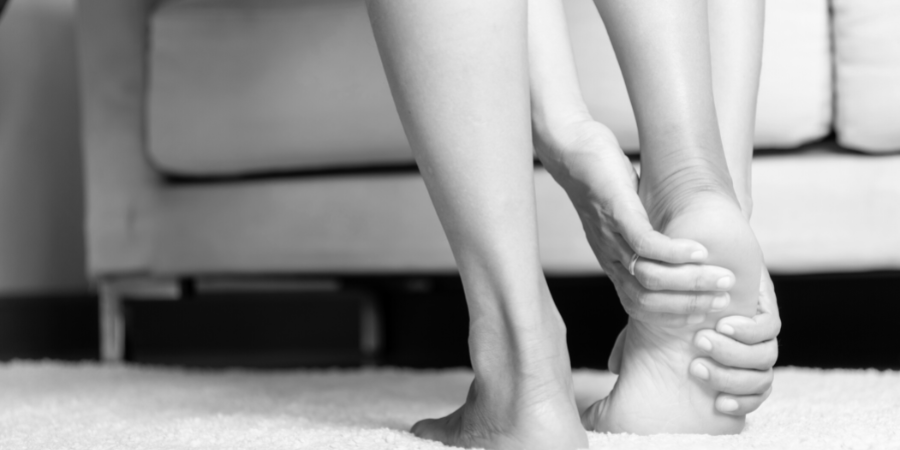Plantar fasciitis: what is it, how to treat it, and how to prevent it
Ever woken up in the morning and found yourself hobbling for the first few steps? If you also have pain on the bottom of your foot, it could be plantar fasciitis. In this blog, we’ll dive into how to treat plantar fasciitis at home and prevent it coming back, so you can start the day with a spring in your step.
What is plantar fasciitis?
Plantar fasciitis is an inflammation of the plantar fascia, the thick tissue which runs along the bottom of your foot and extends in a fan-like shape from your heel to your toes. It generally causes pain on the sole of your foot near your heel or arch, and can affect one or even both feet.
With plantar fasciitis, the pain is usually worse:
- in the morning when you take your first steps of the day
- after you’ve been inactive for a while – this could be working at the computer, resting, or driving
- after intense exercise.
The pain usually eases after a few minutes of walking, and you generally won’t feel pain at all when you’re playing sport or exercising. While plantar fasciitis often starts as general stiffness, it can progress to sharp, stabbing pain if left untreated. This can feel like a knife sticking into the bottom of your foot. (Ouch.)
What causes plantar fasciitis?
As with most injuries, plantar fasciitis can occur for no clear reason, but it generally relates to over-stretching or overuse. There are some risk factors to be aware of:
- High impact activity such as dancing, netball, and running.
- Introducing new exercise to your routine, or doing too much too quickly. Plantar fasciitis often affects runners who ramp up their training program before a long distance event.
- Standing on hard surfaces all day – shout out to all the nurses, doctors and teachers who spend the day on their feet.
- Running on hard or unyielding surfaces.
- Wearing shoes with poor arch support.
Anatomy can also play a part. You’re more at risk if you have flat feet, high arches, tight calf muscles, or are carrying extra kilos. These factors simply place more load or strain on the plantar fascia and can cause tiny tears to the tissue which supports the arch of your foot. Plantar fasciitis is also most common for those in the 40–60 age bracket.
How do you treat plantar fasciitis?
It may not have a catchy acronym like RICE, but we suggest RISSSST is the best way to treat plantar fasciitis at home.
- Rest. First and foremost, ease off on any activity that involves high impact on the heel, such as jumping, running, or dancing. You don’t need to stop all activity, just pause more vigorous activity until the pain subsides.
- Ice. Ice the sore area a few times a day, for up to 20 minutes. You could roll your foot over an icy water bottle, or try an RE3 ankle ice compression pack.
- Stretching. Incorporate daily exercises to stretch out your calf, Achilles tendon, and plantar fascia. Before you get out of bed, point and flex your foot, and slowly circle the ankle a few times in both directions. Doing this before standing can reduce pain, as the plantar fascia tightens while you sleep.
- Swap. Switch your usual exercise for lower intensity options, such as swimming or cycling.
- Shoes.
- First, replace your runners every 650km or so. When shoes get worn out, they stop supporting and cushioning your feet.
- Even when you’re not exercising, choose footwear with good support and cushioning. Our personal favourites are Frankie 4, but any shoes with proper arch and heel support will help. Just make sure they’re properly fitted and in good condition.
- Make sure you wear shoes, even at home. Going barefoot just puts extra strain on the plantar fascia, particularly on hard surfaces like tiles.
- Use shoe inserts or orthotics for extra heel support if needed. You can buy these from a chemist or podiatrist.
- Slow return. Return to vigorous exercise gradually, taking time to build up your endurance or running distance. Sports Medicine Australia suggests you can return to exercise after a week of no pain. But be patient and go back a step if your foot pain comes back.
- Taping. When you return to sport, it can help to tape your foot for extra support.
You can also take ibuprofen or paracetamol to relieve pain when you need it.
Plantar fasciitis can be intensely painful and sideline you for months if it becomes a chronic condition. But if you treat it early, you’ll get back on the field in no time. (Or running track, yoga studio, or mountain bike trail, wherever your happy place is!)
